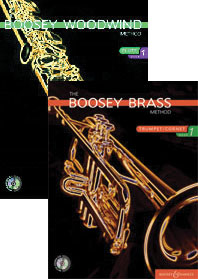Chris Morgan talks abou making good musicians

Making good musicians: Chris Morgan talks about how Boosey Method can help.
The Boosey Woodwind and Brass Method is an original approach to instrumental learning. Chris Morgan, editor of the Boosey Woodwind and Brass Method, discusses the series in more depth
Q: Chris, you’ve previously explained that you devised the Method as a reaction to the bad practice and lack of professional development you’d witnessed in your 30 years of instrumental teaching. Can you explain in more depth what particular concerns you wanted to address?
A: What was clear when I was doing the research for the Method was that instrumental teachers look at technical development as really important. They see it as a priority. But it’s a means to an end for young people, who come to learning an instrument from a different perspective: they want to play.
Q: How have you addressed those different expectations?
A: We have tried to include qualitative musical aspects by making students inquisitive about what they’re playing. At the heart of it is what we’ve called musical encounters. In Book 2 of the Method, for instance, we have introduced a Pavane and Galliard around which we explore such issues as tenuto and accents and how to articulate them. After exploring them we introduce them to pieces. Just before it, they do Colonel Bogey with no accents. So we’re giving students music to play and meeting the technical concerns teachers want to address.
Q: So you’ve not looked at technique in isolation?
A: I have tried to look at the technical side from two angles: from the repertoire perspective and from the means of embedding the technique. That’s one reason why we move away from traditional notation and introduce graphic notations. I have something like starting blocks and hurdles and even the high jump (to explore bigger leaps!). Things like echo games and Q&As help to build on the new notes students are learning. For brass instruments, it’s important to do appropriate warm-ups before lessons, so we’ve included exercises for that.
Particularly in Book 1 of the Method, we have tried to introduce a progression of notes and patterns that don’t get too challenging too soon. We don’t want students to work too hard on rhythmic patterns, for instance. We have also researched a lot of east European repertoire and popular styles which some teachers may want to avoid but which are important in today’s music world and which also raise issues of rhythm.
Q: In effect, it’s an holistic approach you’ve adopted, then…
A: Absolutely. It’s not just about pinning down technique. I’ve always felt from my own teaching experiences that it’s better to get young players involved in the music. And it seems to be an idea that other teachers really value; I’ve had very positive feedback on the idea of non-notation and not being tied down to rhythmic patterns, for instance.
Q: Have you encouraged teachers to put these ideas into practise more directly?
A: Yes, I’ve been involved in In-Service Training (Inset). The Method is basically an affirmation of good practice and it’s helped open another door into effective teaching.
It’s helping to undo the limited training opportunities that successive generations of instrumental teachers have experienced.
Q: What do you think teachers most gain from the Method?
A: It’s been a great help to teachers because of the intrinsic individual element to it. We’ve tailor-made the music and the commissions to meet the realities of each instrument. For instance, in the trombone method we have left out the note C until as late as possible as it is sixth position and difficult. So we’ve developed a lot of repertoire that avoids the note. Students would probably knock their teeth out if they went quickly from sixth to first position on the trombone!
Q: And what do students gain?
A: I hope it’s the ability to explore and to think for themselves about music. Take Book 2, where we have introduced alternative fingerings for certain notes. The youngster can face up to the issues created by that and we encourage them to go back to a particular piece and try out their favoured fingering. It’s all about developing the music and the technique in tandem. That’s what makes good musicians.
Visit the Boosey Woodwind and Brass Method website for regular updates
© Impromptu Publishing Ltd 2003
> Weitere Informationen zur Reihe: Boosey Woodwind & Brass Method
